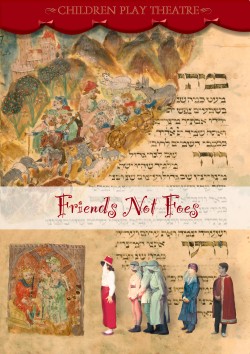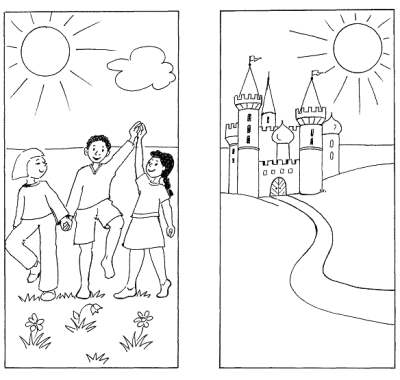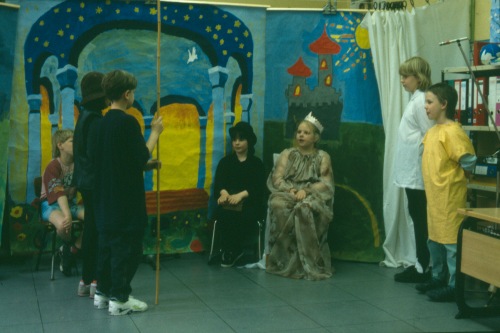|
~ Friends not Foes ~ Summary
Excerpts: Friends not Foes 1. Scene The stage set is divided into three parts. On the left part one can see some dancing children of different races and skin colours, on the central part a field with flowers, trees and butterflies. On the right parts a king’s castle is visible. In front of it stands a throne. 5 narrators sit on the stage. Narrator 1: Once upon a time, a long time ago, there was a large kingdom. Narrator 2: The king ruled fairly and wisely and all the inhabitants were very happy with him. Narrator 3: And therefore they gave him many gifts. The king comes on stage and sits on the throne. Then some inhabitants appear with gifts which they put down in front of the king, bowing to him. Then everyone apart from the narrators leave the stage. Narrator 1: All the inhabitants would have been entirely happy if there hadn’t been the awful distorting-glasses-plague. Narrator 2: This plague could strike the inhabitants in all parts of the kingdom. Often it started in just one place but then it spread inexorably. Narrator 3: The strange thing about it was, that the inhabitants who were struck by the plague, did not feel sick at all. Narrator 4: Dear audience, now see, what happened one day in Southland. 2. Scene The central stage set has been changed. It now shows a village in a primeval forest with aborigine huts. Some inhabitants of the village sit in front of their huts and do different things. E.g. they grind grains to make flour, they cook, etc. A narrator sits in front of the left stage set. A sign reads “In a Village in Southland”. Villager 1: It will be a nice day today. It won’t rain and we can go into the fields to bring in the harvest. Villager 2: Yes. The harvest will be good this year. Villager 3: And so I’m sure that we will celebrate with a nice feast after the harvest. Villager 4: Definitely! Now several soldiers and their captain come on stage. They are armed with bows and arrows and swords. They line up in rank and file. The captain stands slightly ahead of them. Captain: (to the villagers) Hello Villagers. Go and get the mayor for me. I want to tell him something. .... Characters,
scene by scene
Proposals for sceneries:
Scene 2 – central part
A village in the jungle ....
Scene
1 to 5 – left side
Scene 1 + 5 – right side
Photos of a production:
|
||||||||||||||||||||||||||||||
|
webmaster: designcase.net Copyright © 2007 kinderspielentheater.de |
||||||||||||||||||||||||||||||





